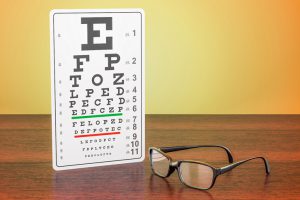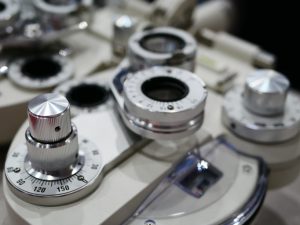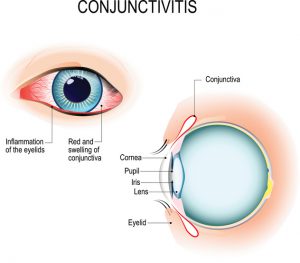I See You: All You Need To Know About Caring For Your Eyes
by Chantel DaCosta Nov 26, 2018

For the sighted, our eyes are the most used sensory organ, and taking care of our eyes is very important.
Yello is your trusted guide, and we here to help you know all you need to know about taking care of your eyes.
- How Often Should You Get Your Eyes Tested? Your eye doctor may choose to test your eyes using the most basic method – the eye chart, or very advanced testing with high powered lenses. But, when do you need to get your eyes tested?
- Choosing An Eye Doctor: Choosing an eye doctor is an important part of your visual health care. There are two types of eye doctors: optometrists and ophthalmologists, which one do you need?
- Types of Eye Tests: There are many types of eye tests, many of these are performed during a comprehensive eye examination.
- The Most Common Eye Conditions and Diseases: Colour blindness, astigmatism, retinal detachments, glaucoma, conjunctivitis, and others.
When Should You Schedule That Eye Exam?
Ideally, it is recommended that eyes are tested once per year.
However, certain changes in your vision may suggest that you need to get your eyes tested now. Here are five signs to look out for that will inform when you get those eyes tested.
- You have started to hold books further away from your face. And squint in order to view the words clearly. (I know that feeling!)
- Your eyes are itchy, red, and irritated.
- You have diabetes or another health condition that affects your eyes.
- You’ve noticed obvious changes in your vision such as seeing spots, flashes of lights or floaters.
- You experience severe eye strain, headaches or blurred vision when using a computer.
Choosing An Eye Doctor Based On Your Needs

Optometrist doing sight testing for patient.
Do you think you need glasses?
Or do you simply want to get your eyes examined and undergo a comprehensive eye exam? If so, then who do you turn to for this service?
These are the two types of eye doctors that you need to know: ophthalmologists and optometrists.
Optometrists
Optometrists are also known as Doctors of Optometry. These doctors examine, diagnose, treat, and manage diseases, injuries, and disorders of the visual system. These involve treatments of the eye, and associated structures as well as identify related conditions affecting the eye.
Ophthalmologists
In medicine, ophthalmology is the study of the anatomy, physiology, and diseases of the eye. Ophthalmologists provide the full spectrum of eye care. This includes: the prescription of glasses and contact lenses, medical treatment, and complex microsurgery.
And, it is also useful to understand the third “O” in eye care, Opticians. Opticians are not doctors. But, they are technical practitioners who design, fit and distribute corrective lenses.

Eye chart and glasses on the wooden table.
Types of Eye Tests
Here are the eye and vision tests that you are likely to encounter during a comprehensive eye exam:
- Visual Acuity Eye Test: This is the common eye chart or the standardised Snellen chart that is used to test and measure your distance visual acuity, how far you can see and at what size. Persons are asked to cover one eye and stand at least 20 feet away and read the letters on the chart.
- Cover Test: The cover test is one of the simplest and most common eye tests. During the test, the doctor will require you to focus on a small object across the room while an eye is covered. The doctor will assess how accurately the uncovered eye can focus on the object.
- Colour Blindness Test: This screen test checks for colour vision deficiencies. The test is called the Ishihara Colour Vision Test. This involves the use of a booklet within which each page has a circular plate of many dots of various colours with varying degrees of brightness and size. The seemingly random coloured dots are arranged so that a person with normal colour vision will see a number within the array of dots. But a colour-blind person will not be able to see this number.
- Eye Movements Test: The ocular motility test or eye movement test will check how well your eyes can follow a moving object. It also determines how quickly your eyes will move between and accurately fixate on two separate targets. Problems with eye movements can cause eye strain and may affect reading ability, and the capability to play certain sports.
- Stereopsis (Depth Perception) Test: This test will assess the perception of depth by using a pair of 3-D glasses and looking at a booklet of test patterns. Each pattern features four small circles, and the task is to point out which circle in each pattern looks closer to you than the other three circles.
- Retinoscopy: This eye exam is used to determine an approximate prescription for eyeglasses. In retinoscopy, the room lights are dimmed and you will be asked to focus on a large letter target on the eye chart. As you stare at that letter your eye doctor will shine a light at your eye and flip lenses in a machine in front of your eyes. This test estimates which lens powers will effectively correct your distance vision.
- Refraction: This test goes beyond the estimation of the retinoscopy. A refraction test will determine an exact prescription for eyeglasses. Unlike the other tests, this one uses a special instrument called a phoropter. This is used to show a series of lens choices and a prescription for glasses are made from the best choice.
- Slit Lamp Exam: A slit lamp is a binocular microscope that doctors use to examine the structure of the eye. During this eye test, you will be asked to place your forehead and chin securely against the props on the front of the instrument. The doctor will then review the structures of the eyes including eyelids, cornea, and lens. This test can detect eye diseases and disorders such as cataracts, diabetes eye disease, and corneal ulcers.
- Glaucoma Test: The main test for glaucoma measures pressure inside your eyes. This is done primarily using the “puff of air test” which is also known as the non-contact tonometry, or NCT. The air puff test gives an eye pressure reading, known as intraocular pressure (IOP), which helps detect glaucoma.

Optometry eyesight measurement equipment
The Most Common Eye Diseases and Conditions That You Need To Know
Here are common eye conditions and diseases that may affect us.
Eyestrain
This happens to all of us. Long hours working at a computer, snuggled reading your favourite book, or, driving very long distances, your eyes may be strained. This will usually go away after a rest period.
Red Eye
Are your eyes bloodshot? The surfaces of the eyes have blood vessels that expand when irritated or infected which result in your eyes becoming red. Red eyes can be attributed to eye strain and tiredness. It is also one of the first symptoms of another eye condition, conjunctivitis or “pink eye”.
Night Blindness
Many persons complain about not seeing well at night. Many are unable to drive at night which is a condition known as night blindness. Some people can’t see clearly in dark rooms, like movie theatres. This is something that can develop during your life as you age or it can be something that you are born with.
Lazy Eye
An amblyopia or lazy eye occurs when one eye doesn’t develop properly. Vision is weaker in the eye that is affected which tends to move around unfocused while the other eye is focused. If detected early, this condition can be corrected. Corrective methods involve wearing glasses or contact lenses and using a patch or other strategies to make a child use the lazy eye.

Conjunctivitis. pink eye (with inflammation).
Conjunctivitis (Pinkeye)
Pink eye occurs when the tissue that lines the eyelids and covers the cornea becomes inflamed. This causes redness, itching, burning, tearing, and discharge.
Cross Eyes (Strabismus) and Nystagmus
Eyes that are crossed, that is, the eyes are not aligned, is a condition known as strabismus. An ophthalmologist can perform surgery to correct this. Another crossed eye challenge is nystagmus, the constant and involuntary movement of the eye.
Colour Blindness
When you are unable to see certain colours or cannot distinguish between two colours, then you may be colour blind. Colour blindness happens when the colour cells in the eye, or cone cells, are absent or don’t work correctly.
Uveitis
Uveitis is the name for a group of diseases that cause inflammation of the uvea, the middle layer of the eye.
Presbyopia
This is commonly associated with aging, after age 40, when people experience blurred near vision when reading, sewing or working at the computer.

Astigmatism diagram with human eye cross-section to illustrate the difference in impaired vision and normal sight.
Astigmatism
Astigmatism is a refractive error affecting how the eyes focus. Distorted images are the result when the light fails to come to a single focus on the retina to produce clear vision. Instead, multiple focus points occur. Astigmatism usually causes blurred vision or distortion at certain distances at some degrees.
Floaters
Floaters are those tiny spots that float across your field of vision. Most people will notice them on a bright day. Floaters are usually normal; however, they can sometimes be a sign of a more serious eye problem known as retinal detachment.
Retinal Detachments
The retina is the light-sensitive extension of the brain that lines the inner surface of your eyeball. Retinal detachment can happen in main two ways.
- Exudative Retinal Detachments occur when the collection of fluid between the retina is detached from the coats of the eye. In these instances, the eye fails to function properly leading to blurred vision in the area of the detachment.
- Rhegmatogenous Retinal Detachments transpire when holes or breaks in the retina allow fluid from the vitreous cavity to lift the retina from the outer coats of the eye.
Dry Eyes
Dry eyes occur when tear glands are unable to produce enough quality tears. Dry eyes are uncomfortable and can cause you to feel that something is in your eye or create a burning sensation.

Cataract is a dense cloudy area that forms in the lens of the eye.
Cataracts
A cataract is a gradual clouding of the lens in the eye. The resulting effects are blurry or hazy images and sensitivity to light. Cataracts can be removed by an ophthalmic surgeon. The ophthalmologist can remove the damaged lens and replace it with an artificial one.
Glaucoma
Glaucoma is the name for a group of eyes diseases which damage the optic nerve because of an increase in eye fluid pressure. Treatment may include prescription eye drops or surgery.
Corneal Diseases
The cornea is the transparent skin that covers the outside layer of the eye. It helps to focus the incoming light. Disease, infection, injury, and exposure to toxic substances can damage the cornea. Common symptoms of cornea diseases are eye redness, watery eyes, pain, reduced vision, or a halo effect.
Many eye conditions are minor and will eventually go away with little or no treatment required. Meanwhile, others are far more serious and require medical treatment and monitoring.
This article is intended for interest only and is not written by medical professionals. It is always best to seek a trained doctor’s advice on managing all healthcare concerns and illnesses.
If you need any additional healthcare advice on taking the best care for your eyes, please see licenced optometrists and ophthalmologists.
Sources: WedMD, Ottawa Hospital, All About Vision, Health Works Collective, Mayo Clinic, Very Well Health and, CARPHA.








